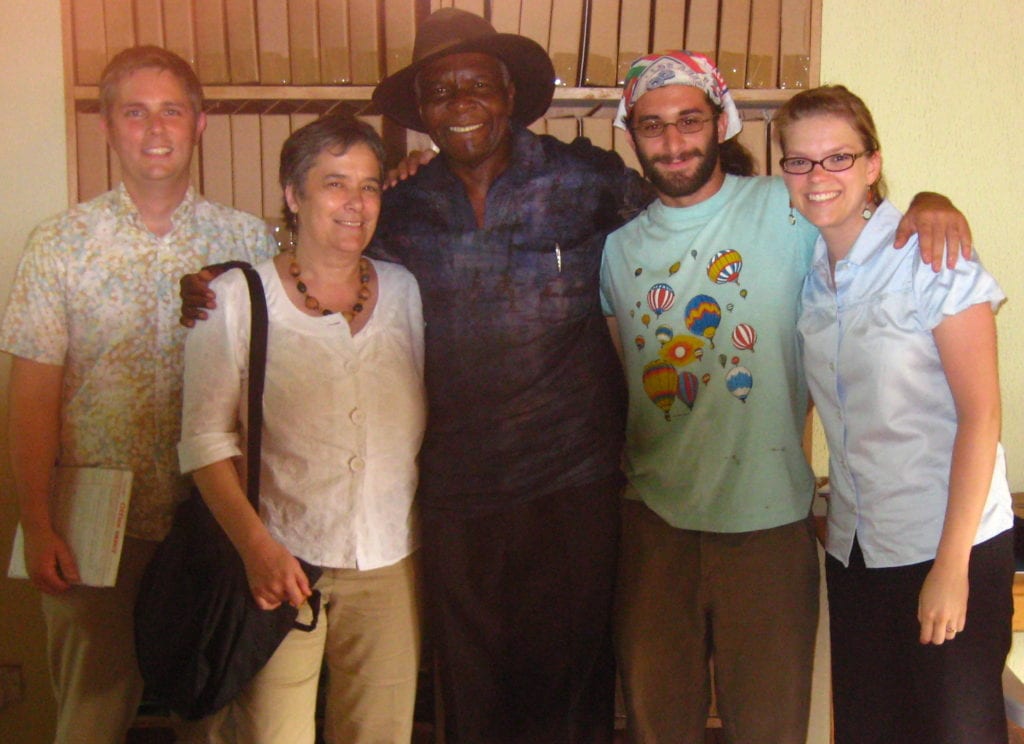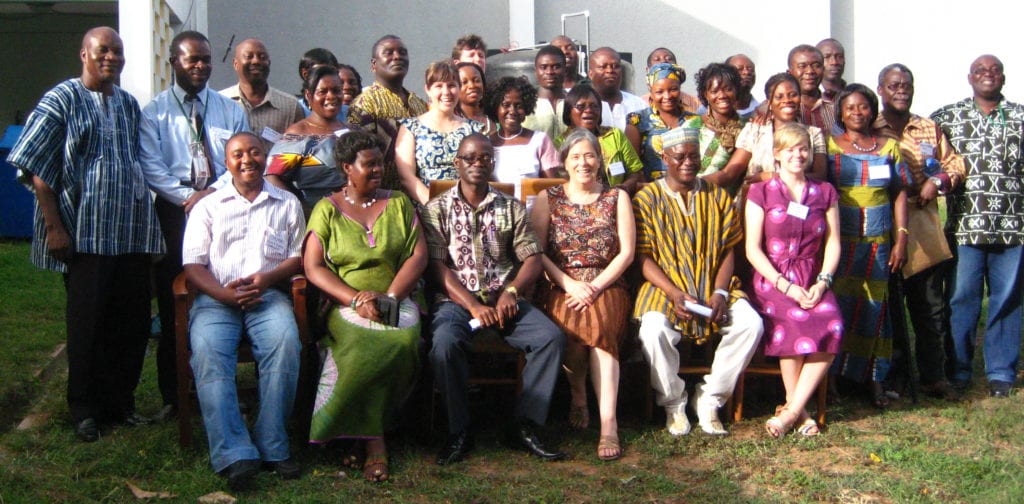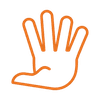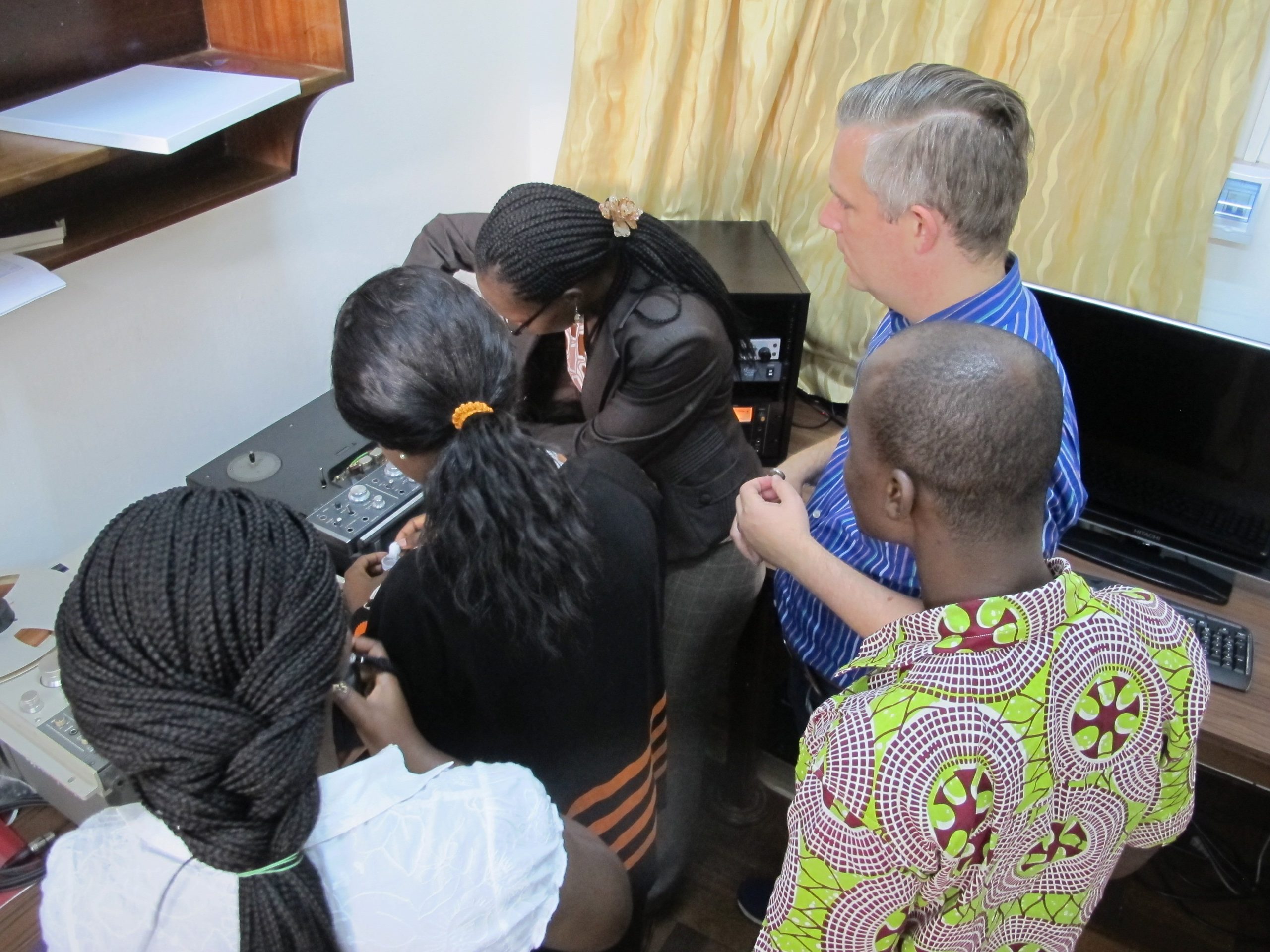IASA Keynote: Designing Sustainable Collaborations for Impact
October 18, 2018
Little known fact about me: I have visited Ghana 9 times in the past 11 years. It has actually been one of the greatest privileges of my career thus far to work with NYU professor Mona Jimenez and several other collaborators helping build capacity for audiovisual archiving with the archives, broadcasters, libraries, and museums in Ghana. So I was excited and honored when the board of the International Association of Sound and Audiovisual Archives (IASA) invited me to present the closing keynote at their 49th annual conference, which was held in Accra, Ghana, October 1-4, 2018. It was an incredible event, and I am eternally grateful to the IASA board for letting me share this story.

Chris Lacinak, Mona Jimenez, Kwame Sarpong, Seth Paris, Kara Van Malssen (author) in Ghana, 2008.My presentation was titled, “Designing Sustainable Collaborations for Impact.” I wanted to talk about AVP’s approach to partnering with clients, and demonstrate how the work we do with our clients everyday follows a tried and tested model for collaboration. My goal was to equip the audience with a strategy for cooperation that they could easily apply to their own partnerships, and to illustrate the model using the example of our work in Ghana over the years — better known as Audiovisual Preservation Exchange (or APEX) Ghana — sharing our successes, and a few failures. Lastly, I wanted to take the opportunity to highlight the amazing achievements of Mona and our close friend and colleague, Judith Opoku-Boateng, Archivist at the J.H. Kwabena Nketia Archives at the Institute of African Studies, University of Ghana. As I hope you’ll see, these two wonderful women are really the heroes of this story.
You can find my slides here:
Below, I’ll do my best to summarize what I said in that presentation. Note that to keep this post a brief as possible (which, in fact, is not so brief), I’ve omitted a lot of details, names, and thank-you’s to so many people.
Here at AVP, we work with a variety of clients on diverse projects. Though each project is unique, and requires different activities, there is a consistent approach we apply to each engagement. We’ve developed this approach over time as we’ve learned what it really takes for a collaboration to be successful. You need the right people, leadership, tools, and processes. If you are missing just one, the effort might be in jeopardy. So to continually ensure that things stay on track, we take the following steps:
✔️ Confirm
Before any project begins, we want to make sure that it is set up for success. We ask ourselves and the client a set of key questions:
-
- Is there a project champion?
- Is there buy-in from leadership and other key stakeholders?
- Is there a clear vision for how the outcome of the engagement will be put to use?
If any of these questions don’t have an answer, or if the answer is unclear, that’s a red flag, an indicator that more work needs to done on the client side to define the project. Once we feel confident that these elements are in place, we can begin.
Discover
The first step in any project is to learn as much as we can about the organization, the challenges, and the goals. We want to uncover the root issue, which may not always be apparent at first, so we can solve for this. We try to immerse ourselves as much as possible through interviews, demonstrations, observation, and review of documentation and datasets. We do our best to put aside our assumptions. And it doesn’t necessarily just happen once — we might conduct a discovery processes repeatedly throughout an engagement as our understanding evolves (and we realize more what we don’t know).
Ideate
We work with the client to define realistic goals and solutions to their challenge. While these are informed by standards as much as possible, they are adapted to the local situation. At this stage, all ideas are welcome, and encouraged, from all stakeholders. Again, this doesn’t just happen once — we may return to the ideation stage multiple times throughout the engagement.
Iterate
We take incremental steps toward the goal so that we can continually check to ensure that we are on the right path, and showcase small wins as we go along. If we need to shift course as we go along, that’s much easier to do when we take an iterative approach.
️ Demonstrate
Successes, however small, must be shared. And as much as we like to showcase wins, these are our clients’ stories to share, not our own. Successes are likely to yield more successes. And even failures are successes when we learn from them and apply that knowledge.”][/nectar_icon_list_item][/nectar_icon_list]
Alongside this we have collaboration and trust, which go hand-in-hand, and must be present throughout the engagement. Honesty and transparency are critical components to successful collaborations.
Let me talk about how this applied to our work in Ghana.
In 2008 Mona Jimenez, Chris Lacinak, and I traveled to Ghana to teach a workshop to participants of the Real Life Pan-African Documentary Film Festival, co-organized by NYU Accra (a study abroad program for NYU students), and help out our friend Seth Paris who was on a Fulbright there. Knowing next to nothing about the situation of audiovisual archives in Ghana, we decided to take the opportunity to do some research. In addition to the workshop we provided to the documentary filmmakers, we spent 3 weeks meeting with folks at institutions including broadcasters, the local film school, the Ministry of Information, and private collections. We listened to the challenges of the caretakers at these institutions, evaluated their collections, and talked with them about their goals. We met with prominent members of the film industry. We participated in a heated discussion during a panel on the state of audiovisual preservation in Ghana.
What were we asked for over and over by everyone we met? Training.
2009 APEX Ghana training team and participants
So, in 2009, we returned with the film festival, but this time expanded our training effort to include a 5-day workshop for caretakers of audiovisual collections in Ghana. We brought experts Mick Newnham of the National Film and Sound Archive of Australia, and Ishumael Zinyengere, then at the UN Criminal Tribunal for Rwanda. We didn’t know exactly who would come or what they’d specifically want to learn so we based the curriculum on what we heard and seen the previous year. We delivered an audiovisual archiving 101 workshop, covering collection assessment, video and film composition, care and handling, cataloging, selection and preservation, storage, and networking. We had about 25 participants from 10 or so institutions. And we participated in another exciting panel during the conference about the state of film preservation in Ghana.
We realized by the end of the week that, although we had covered a lot of ground, it wouldn’t be enough to really empower the participants to make the changes they wanted to see. We decided to go back again in 2010. This time, we only did a 2-day training, focusing on fundraising and video preservation based on the input of participants the previous year. And there was another panel.
But there was still more to do.
In 2011 we came back to conduct another 5-day training. This time, we wanted to motivate participants to shape a concrete project plan, and actually have a shot at getting it funded. We were fortunate to receive a $1000 donation from Jim Lindner of Media Matters, and created a challenge grant for the workshop participants. We spend the week discussing how to scope, budget, and pitch project plans, and proposals were submitted one week after the workshop.
That year we also held a screening of films made in Ghana that had been found in US and Ghanaian collections. We wanted to show the power of historical audiovisual content to tell a story. One of the highlights was this home movie footage featuring Ghana’s first president Dr. Kwame Nkrumah with American journalist and entrepreneur, Claude Barnett. One of the younger members of the audience commented: “I’ve seen so many pictures of Dr. Nkrumah, but I’ve never seen him move,” drawing attention to the challenges Ghana has faced in the preservation of its audiovisual heritage.
Claude Barnett in Ghana (1957) from Kara Van Malssen on Vimeo.
At the time, we thought that would be our last visit. We had reached the limits of what we felt we could do only coming once a year and conducting short-term trainings. We were also getting frustrated that our workshop participants didn’t seem to be making much progress.Looking back at our model for successful collaborations, how well did we follow through during those four years? Here is how I score us on a scale of 0-5 (5 being the best):
 |
Discovery | I give us high points for this because we did take the time to really learn about the organizations and the state of their archiving programs. That’s not always done with training initiatives. |
 |
Ideate | We did well to think of different ways that we could create a broad-reaching training, but we didn’t take it a step further and question whether training was really what people needed, or how to make the training truly impactful to the participants organizations. |
 |
Iterate | We did iterate on our training, but we kept coming back to the same solution: more training. I do think the Jim Lindner award did kick things up a notch in a great way. |
 |
Demonstrate |
We participated in panels. We were on the news. We held screenings. These sparked productive conversation. But they didn’t seem to be pushing forward change. Perhaps it was too much of us (the consultants/trainers) telling the story, and not enough of the local participants.
|
You’ll notice that I skipped over the first step in our model: Confirm. And that’s because we didn’t do this. And looking back on why the training initiative didn’t have the impact we wanted it to, I’d say that it comes down to neglecting this step. As a result:
- Participants were not empowered to make change;
- There was no buy-in from leadership at their organizations;
- There was no vision or roadmap for how to apply what was learned;
- And there wasn’t true collaboration (it was all one way).
But, our story doesn’t end there. Because 2011 was the year we met Judith Opoku-Boateng, Archivist at the Institute of African Studies (IAS), University of Ghana. And remember that challenge grant I mentioned? She won it. Unlike the other proposals we received, Judith had a very concise, realistic plan. It was a small project, but her proposal was clear how it would lead to bigger changes. And she had a vision of what she wanted to achieve in the long-term.
So when we thought about what we might want to do in Ghana in the future, if anything, we thought of possibly pivoting to more direct mentorship model. Could this work with the IAS? This time, we made sure to confirm that the elements of success were present:
- There was a project champion (Judith);
- There was a clear vision;
- There was buy-in from senior leadership;
- And there was buy-in from supporting stakeholders, including faculty and IT.
In 2012, we returned to Ghana, and started from scratch. We conducted a collection assessment of the IAS Archive’s audiovisual materials that produced a 65-page report detailing the collection’s content, formats, condition, and priorities. It included a roadmap and budget. We met with the leadership at the Institute of African Studies (IAS), and at the University of Ghana central IT and library IT to establish relationships and eventual partnerships for digital preservation.
In 2013 we returned to help Judith further promote the plan and solidify relationships. We met with key stakeholders amongst faculty and research fellows who had a strong interest in using the archive’s collections. Consensus was beginning to form amongst the local partners, and as external collaborators, our commitment to the success of the project was clear. We all agreed to focus on planning to create a digitization lab, starting with ¼” open reel audio tape.
IAS got to work right away, renovating space and allocating an additional 4 rooms to the archive, promoting Judith to Archivist (a faculty position), and creating an additional two full-time staff positions. Additionally, IAS Professor Essie Sutherland-Addy had received some equipment for digitization of her own ¼” audio research materials, which she donated to the archive to support the creation of a service hub. Meanwhile, AVP started designing the lab and sourcing additional required equipment.
In 2014, Mona and I returned along with AVP President Chris Lacinak, and our collaborator Seth Paris (who had spent time in Ghana on a Fulbright a few years back, and was a friend to the archive). We spent a week installing the equipment, troubleshooting and resolving issues, implementing software, updating the database, and developing workflows. Replication and backup to UG’s central computing centre was put in place. Seth stayed on an additional two weeks to help train staff and create documentation.

Shortly after, the archive was officially dedicated and named the J.H. Kwabena Nketia Archives, after the illustrious ethnomusicologist whose recordings from around Ghana and other parts of Africa made in the 1950s and 60s are one of the jewels of the collection (the 96-year-old still comes by the archive regularly to meet with patrons).
The Nketia Archives has made tremendous progress in the years that have followed:
- A large volume of content is now accessible: 800 hours digitized, 2500-3000 detailed catalog records)
- There is constant demand: student groups and individual researchers visit daily, international researchers come and stay for 1-12 months
- The Nketia Archives has become a model in the region: ICCROM’s SOIMA course was held at the Nketia Archives in 2017 and was attended by 20 participants from around the globe, Nketia Archive team members help and train staff at other archives in the region, and deposits and donations are increasing
And perhaps one of the clearest signals of the success of this effort is that the 49th annual IASA conference was successfully organized by the Nketia Archives and hosted at the University of Ghana!
There is undoubtedly more work to be done. The Nketia Archives has many more materials, in many different formats, that need to be digitized. They are looking to build capacity for video preservation in the near future by adding technical capability to migrate these formats, and to get specialized training for their staff. But the successes seem to be snowballing, and I only expect more great things to come from this team.
So, how did we score against the model for successful collaborations the second time around?
 |
Confirm | We took a step-by-step approach, confirming commitment and vision on all sides before initiating, and then again before moving along to each phase. |
 |
Discovery | Aside from our extant knowledge of Ghana and archives in the region, we left our assumptions behind and went into the assessment of the archives with an open mind. We gathered extensive information through object evaluation, documentation and data review, and stakeholder interviews. |
 |
Ideate | Working collaboratively, we came up with realistic, achievable solutions. |
 |
Iterate | All stakeholders contributed bit by bit over time, and with each step’s demonstrated impact, further successful steps were enabled. |
 |
Demonstrate | The story has been shared and continues to be, locally and internationally. But the greatest part of this is that, with a few exceptions (like my talk and this blog post), the Nketia Archives team are the ones sharing THEIR story. |
The last point underscores one of the most critical effects of successful collaborations — that there are no dependencies on the mentor, and that at a certain point, the mentee will keep progressing forward on their own.
That’s definitely a sign of a successful engagement here at AVP: when our clients no longer need us.